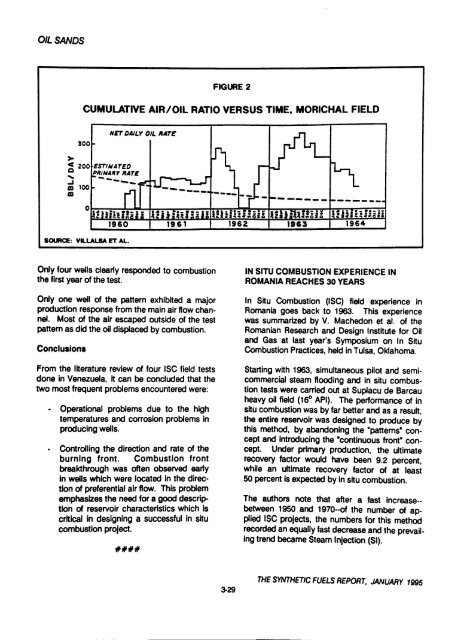Ikelic - Alliance Digital Repository
Ikelic - Alliance Digital Repository
Ikelic - Alliance Digital Repository
You also want an ePaper? Increase the reach of your titles
YUMPU automatically turns print PDFs into web optimized ePapers that Google loves.
OIL SANDS<br />
FIGURE 2<br />
CUMULATIVE AIR/OIL RATIO VERSUS TIME, MORICHAL FIELD<br />
< 200\STI HATED<br />
NET DAILY OIL MATE<br />
1960<br />
SOURCE: VH.LALBA ET AL.<br />
il*jti sit<br />
i>iiiiieo<br />
1961<br />
Only four wells clearly responded to combustion<br />
the first year of the test.<br />
Only<br />
one well of the pattern exhibited a major<br />
production response from the main air flow chan<br />
nel. Most of the air escaped outside of the test<br />
pattern as did the oil displaced by combustion.<br />
Conclusions<br />
From the literature review of four ISC field tests<br />
done in Venezuela, it can be concluded that the<br />
two most frequent problems encountered were:<br />
- Operational<br />
- Controlling<br />
problems due to the high<br />
temperatures and corrosion problems in<br />
producing wells.<br />
the direction and rate of the<br />
front. Combustion front<br />
burning<br />
breakthrough was often observed early<br />
in wells which were located in the direc<br />
tion of preferential air flow. This problem<br />
emphasizes the need for a good descrip<br />
tion of reservoir characteristics which is<br />
critical in designing a successful in situ<br />
combustion project.<br />
####<br />
3-29<br />
1962 1963 1964<br />
IN SITU COMBUSTION EXPERIENCE IN<br />
ROMANIA REACHES 30 YEARS<br />
In Situ Combustion (ISC) field experience in<br />
Romania goes back to 1963. This experience<br />
was summarized by V. Machedon et al. of the<br />
Romanian Research and Design Institute for Oil<br />
and Gas at last year's Symposium on In Situ<br />
Combustion Practices, held in Tulsa, Oklahoma.<br />
Starting with 1963, simultaneous pilot and semicommercial<br />
steam flooding and in situ combus<br />
tion tests were carried out at Suplacu de Barcau<br />
(16<br />
heavy oil field API). The performance of in<br />
situ combustion was by far better and as a result,<br />
the entire reservoir was designed to produce by<br />
this method, by abandoning the "patterns"<br />
con<br />
cept and introducing the "continuous front"<br />
con<br />
cept. Under primary production, the ultimate<br />
recovery factor would have been 9.2 percent,<br />
while an ultimate recovery factor of at least<br />
50 percent is expected by in situ combustion.<br />
The authors note that after a fast increase-<br />
between 1950 and 1970-of the number of ap<br />
plied ISC projects, the numbers for this method<br />
recorded an equally fast decrease and the prevail<br />
ing trend became Steam Injection (SI).<br />
THE SYNTHETIC FUELS REPORT, JANUARY 1995















![pace SrntfletIc fne]its report - Alliance Digital Repository](https://img.yumpu.com/10493335/1/190x245/pace-srntfletic-fneits-report-alliance-digital-repository.jpg?quality=85)
